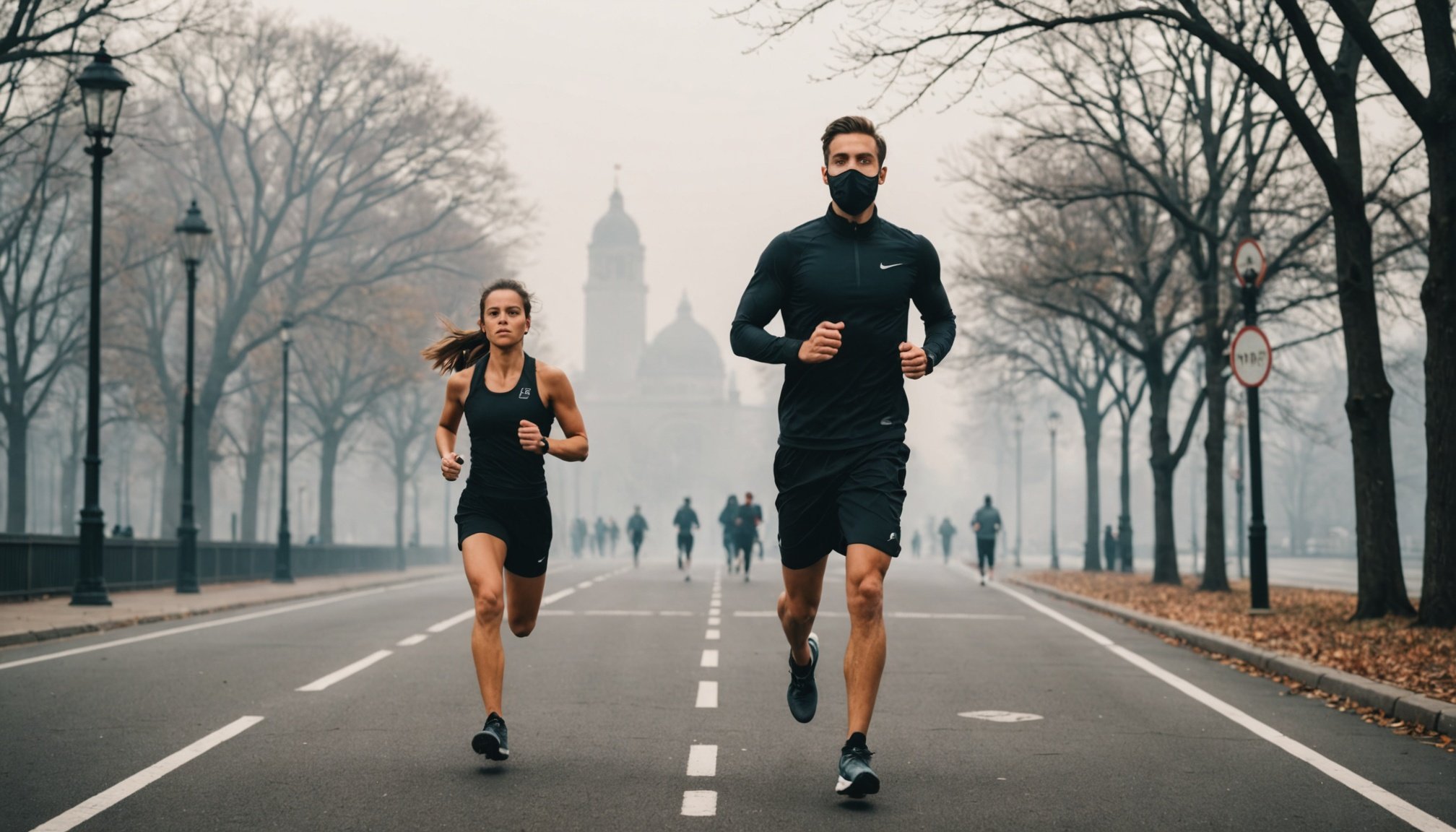How Air Pollution Influences Your Outdoor Workout: Understanding the Effects on Exercise Routines
The Invisible Threat: Air Pollution and Outdoor Exercise
When you head out for a run, a bike ride, or any other form of outdoor exercise, you’re likely focused on your fitness goals and the fresh air. However, there’s an invisible threat lurking in that air that can significantly impact your health and performance: air pollution.
Air pollution is a complex mixture of gases and particles, including ozone, sulfur oxides, nitrogen oxides, particulate matter (PM), volatile organic compounds (VOCs), and polycyclic aromatic hydrocarbons (PAHs). These pollutants can come from various sources such as transportation, industrial activities, and even natural phenomena like wildfires.
Have you seen this : Unleashing the Power of Recovery: The Ultimate Cooldown Routine for Your HIIT Workouts
Immediate Health Effects of Air Pollution on Exercise
During physical activity, you breathe more deeply and frequently, which increases your exposure to air pollutants. Here are some immediate health effects you might experience:
Respiratory Issues
High levels of air pollution can lead to decreased lung function, making it harder for athletes to perform during endurance training. This is because pollutants like particulate matter, nitrogen dioxide, and ozone can irritate the lungs and airways, leading to symptoms such as coughing, wheezing, and shortness of breath.
Also to read : Unlock Your Swimming Potential: The 5 Essential Strength-Training Exercises Every Beginner Should Master
Cardiovascular Strain
Air pollution can also increase cardiovascular strain. Pollutants like fine particulate matter (PM2.5) can enter the bloodstream, causing inflammation and oxidative stress, which can lead to increased heart rate and blood pressure. This is particularly risky for individuals with pre-existing cardiovascular conditions.
Reduced Performance
Poor air quality can negatively influence respiratory function, reduce oxygen uptake, and increase fatigue levels. For endurance athletes, this means reduced performance and potentially shorter workout sessions due to the body’s inability to cope with the polluted air.
Long-Term Health Risks Associated with Air Pollution
The effects of air pollution on health are not limited to immediate symptoms; there are significant long-term risks as well.
Cardiovascular Disease
Long-term exposure to air pollutants is associated with an increased risk of cardiovascular disease, including ischaemic heart disease and stroke. According to the World Health Organization (WHO), in 2019, 68% of outdoor air pollution-related premature deaths were due to these conditions.
Respiratory Diseases
Chronic exposure to air pollution can lead to chronic obstructive pulmonary disease (COPD), acute lower respiratory infections, and lung cancer. For example, in Canada, air pollution was linked to 3.6 million asthma symptom days and 39 million acute respiratory symptom days in 2018.
Other Health Impacts
Air pollution is also linked to other health issues, including reduced cognitive development in children, dementia in later life, and even developmental disorders such as stunting.
Understanding the Key Pollutants
To better grasp the impact of air pollution on your outdoor workouts, it’s essential to understand the key pollutants involved:
- Particulate Matter (PM): Fine particles (PM2.5) and coarse particles (PM10) can penetrate deep into the lungs, causing respiratory and cardiovascular issues.
- Nitrogen Dioxide (NO2): Commonly released from the combustion of fuels in transportation and industrial sectors, NO2 can exacerbate respiratory diseases and increase the risk of cardiovascular disease.
- Sulfur Dioxide (SO2): Produced from the burning of fossil fuels and the smelting of mineral ores, SO2 can cause respiratory problems and contribute to the formation of acid rain.
- Ozone (O3): Formed through the reaction of gases in the presence of sunlight, ground-level ozone is a major constituent of photochemical smog and can irritate the lungs and airways.
Practical Tips for Minimizing the Risks
While it’s impossible to completely avoid air pollution, there are several steps you can take to minimize its impact on your outdoor workouts:
Check Air Quality Before Heading Out
- Use air quality apps or websites to check the current air quality in your area. If the levels are high, consider rescheduling your workout or choosing an indoor alternative.
- Follow local health advisories and early warning systems that recommend avoiding outdoor activities when air quality is poor.
Choose Cleaner Routes
- Opt for routes that avoid heavy traffic and industrial areas, which are typically high in air pollutants.
- Consider exercising in parks or green spaces, which often have better air quality compared to urban areas.
Use Protective Gear
- Wear masks designed to filter out fine particulate matter when exercising in polluted areas. These masks can significantly reduce your exposure to harmful pollutants.
Adjust Your Workout Routine
- If you have a pre-existing respiratory or cardiovascular condition, consult with your healthcare provider to adjust your workout routine based on air quality.
- Avoid high-intensity workouts during periods of poor air quality, as this can exacerbate health issues.
Community and Policy-Level Actions
Individual actions are crucial, but addressing air pollution requires a broader approach:
Advocating for Cleaner Policies
- Support policies that promote cleaner transport, energy-efficient homes, and better waste management. These policies can significantly reduce the key sources of outdoor air pollution.
Community Engagement
- Participate in local initiatives aimed at improving air quality. This could include advocating for more green spaces, supporting public transportation, and encouraging businesses to adopt cleaner practices.
Education and Awareness
- Educate yourself and others about the health impacts of air pollution. Raising awareness can lead to more community-driven efforts to improve air quality.
Air pollution is a silent but significant threat to your health, especially when engaging in outdoor physical activity. By understanding the immediate and long-term effects of air pollution, taking practical steps to minimize exposure, and advocating for cleaner policies, you can protect your health and ensure that your outdoor workouts remain safe and beneficial.
Here is a detailed table summarizing the key points:
| Pollutant | Health Effects | Immediate Symptoms | Long-Term Risks |
|---|---|---|---|
| Particulate Matter (PM) | Respiratory and cardiovascular issues | Coughing, wheezing, shortness of breath | COPD, lung cancer, cardiovascular disease |
| Nitrogen Dioxide (NO2) | Exacerbates respiratory diseases, increases cardiovascular risk | Respiratory irritation | Cardiovascular disease, respiratory diseases |
| Sulfur Dioxide (SO2) | Respiratory problems, acid rain contribution | Respiratory irritation | Respiratory diseases, cardiovascular issues |
| Ozone (O3) | Lung and airway irritation | Coughing, wheezing, shortness of breath | Respiratory diseases, cardiovascular issues |
Key Takeaways
- Air Quality Monitoring: Regularly check air quality before heading out for a workout.
- Route Selection: Choose routes that avoid heavy traffic and industrial areas.
- Protective Gear: Use masks to filter out fine particulate matter.
- Community Action: Support and advocate for policies and initiatives that improve air quality.
- Education: Educate yourself and others about the health impacts of air pollution.
By being informed and proactive, you can mitigate the risks associated with air pollution and ensure that your outdoor workouts contribute positively to your health and well-being.











